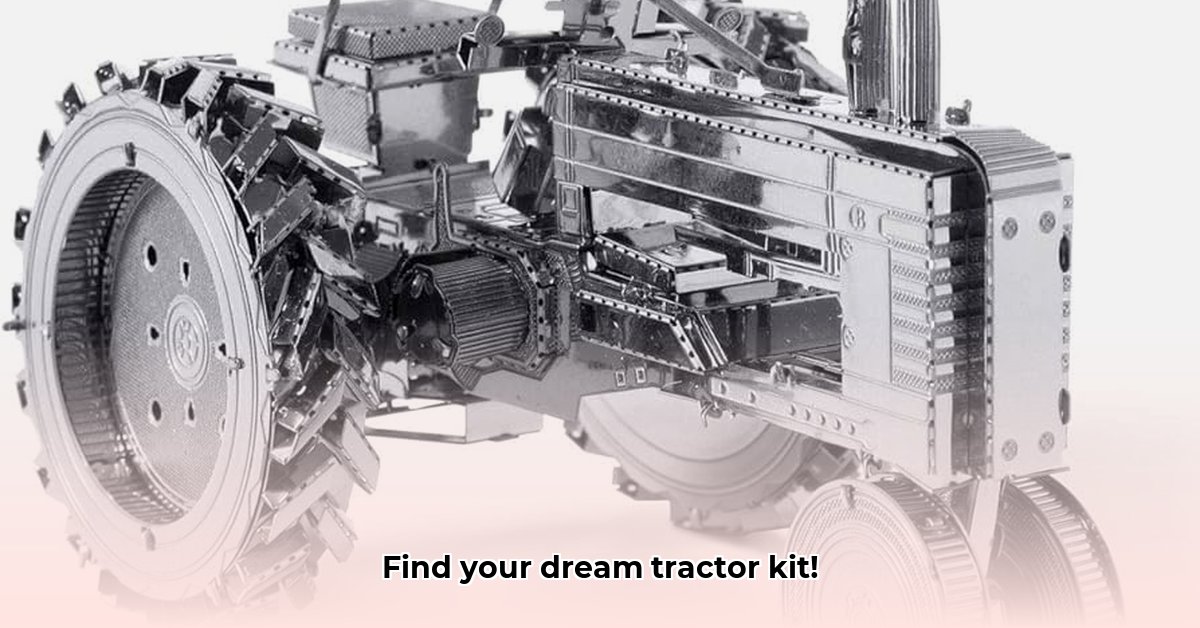
Understanding the Collectible Model Tractor Market
So, you're ready to enter the exciting world of collectible model tractors? Fantastic! This detailed guide will equip you with the knowledge and strategies to navigate this rewarding hobby, whether you're a seasoned collector or just starting. The market for model tractors is surprisingly diverse. It's segmented by scale (the ratio of the model to the real-life tractor, with smaller scales like 1/87 being common), brand (Meng, Mini-Art, Hasegawa, and others each bringing unique styles and levels of detail), and historical significance. Certain brands are known for their accuracy, others for their intricate detail, and still others provide more affordable entry points. Precise market size is difficult to determine due to the scattered nature of sales across various online and physical retailers; however, the hobby's popularity is undeniable, with a clear upward trend observable on major shopping platforms such as Amazon and Hobby Lobby.
For information on specific models, like the Ford 120, check out this resource.
Did you know that the average price of a beginner model tractor kit can range from $15 to $50? This considerable difference highlights the importance of research before purchasing.
Choosing Your First Model Tractor Kit: A Step-by-Step Guide
Selecting your initial kit might feel overwhelming, but this checklist simplifies the process:
Scale: Smaller scales (1/35 or 1/48) are generally easier for beginners, offering fewer parts and a simpler assembly. Larger scales (1/16 or 1/24) provide incredible detail but demand more patience and precision.
Brand Reputation: Research brands before purchasing. Read reviews to gauge quality, detailing, and ease of assembly. Established brands like Revell-Monogram often offer beginner-friendly kits, while Meng, Mini-Art, and Hasegawa are popular for their detailed and accurate models, ideal for more experienced builders.
Detail Level: Examine photos of the kit carefully. Some kits boast simple designs for a quick build, while others offer intricate detail requiring more time and skill. The level of detail directly correlates to the complexity of the build and the necessary tools.
Price Point: Set a reasonable budget upfront to avoid impulse purchases. Prices vary widely depending on scale, brand, detail, and overall rarity.
Top Brands and Models: A Collector's Perspective
Several manufacturers dominate the market, each with its strengths:
Meng Model: Renowned for historically accurate and incredibly detailed models, particularly their John Deere tractors. Expect higher prices but exceptional quality.
MiniArt: Specializes in Eastern European tractors, offering unique models not readily available from other brands. Their kits are known for their intricate details.
Hasegawa: Focuses on Japanese tractors with unique designs and well-engineered kits.
Revell-Monogram: A well-established brand offering a broad selection, including beginner-friendly kits, perfect for learning the ropes. They are particularly strong in iconic American tractor designs and are often more readily available.
For beginners, Revell-Monogram's simpler kits provide an excellent starting point. As you gain experience, explore the highly detailed offerings from Meng and Mini-Art, but be prepared for a more challenging, yet rewarding, build.
Top 5 Kits for Beginners: (This section would include a visually appealing list featuring images and brief descriptions of five beginner-friendly kits, highlighting their features and price points).
Where to Buy Model Tractor Kits: Finding Reputable Sellers
Multiple avenues exist for acquiring your kits:
Online Marketplaces (Amazon, eBay, Hobbylinc): Offer vast selections but require careful review of seller ratings and product descriptions before purchasing. Always verify seller legitimacy and read customer reviews to avoid scams or damaged goods.
Local Hobby Shops: Provide a more curated selection and often have knowledgeable staff who can offer advice and guidance, making them valuable resources for beginners.
Assembling Your Model Tractor: A Step-by-Step Guide
Building your model is a rewarding process! Here's a simplified guide:
Gather Essential Tools: You'll need plastic cement (specifically designed for model kits), a sharp hobby knife for precise cuts, fine-grit sandpaper for smoothing surfaces, and possibly small clamps for holding parts while the glue sets.
Consult the Instructions: Carefully follow the manufacturer's instructions. Each kit provides a detailed manual with step-by-step guidance.
Embrace Patience: Don't rush! Take your time and enjoy the intricate process of assembly. Building models is a calming and rewarding experience.
Optional Painting and Weathering: Enhance realism by adding paint and weathering (techniques to simulate wear and age). Numerous online tutorials provide comprehensive guides for all skill levels.
Displaying Your Masterpiece: Creative Showcase Options
Once assembled, showcase your hard work!
Simple Display: A shelf or curio cabinet provides a straightforward presentation.
Diorama Creation: Elevate your display with a diorama, a small, themed setting that adds context and enhances the visual appeal of your model, adding a unique creative element.
Joining the Community: Connecting with Fellow Enthusiasts
Connect with other model tractor enthusiasts to expand your knowledge, share experiences, and discover new models! Online forums, social media groups, and local model clubs offer invaluable resources and a supportive community.